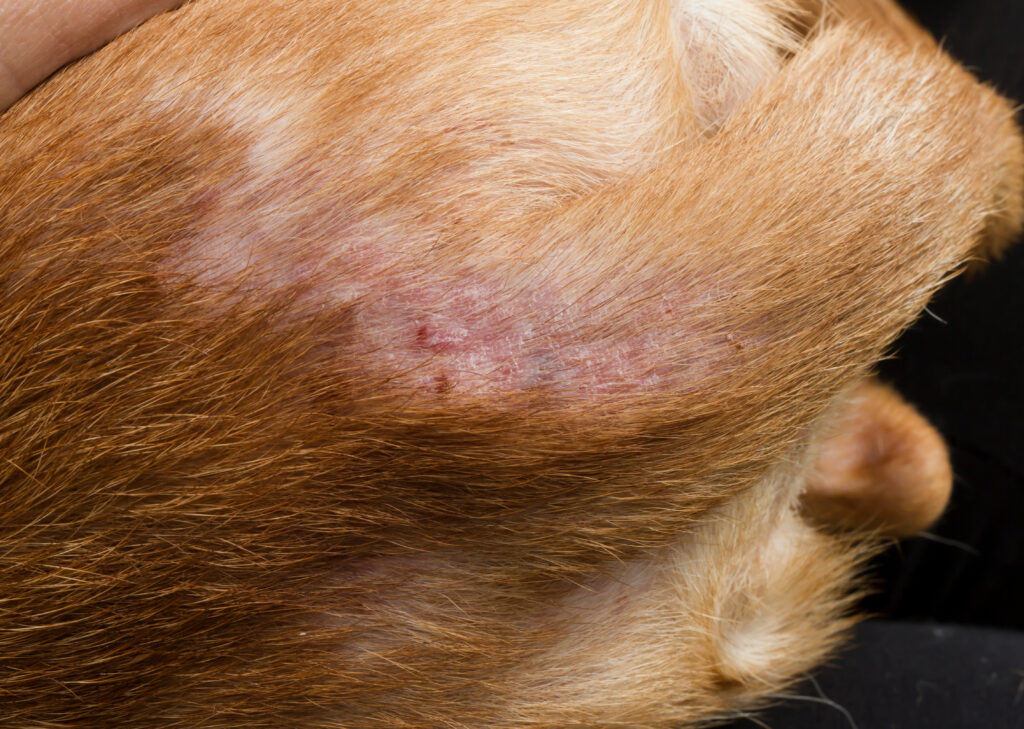Fleas are a common problem for dogs, and their bites can cause significant discomfort. Knowing what a flea bite looks like on a dog is important because it can help you take the best care of your pet and treat their fleas before they get worse. This blog will help you identify flea bites and provide tips on how to keep your dog safe from these pesky parasites. If you suspect your dog has fleas, call Arvada Veterinary Hospital in Arvada, Colorado at (303) 424-4439 or make an appointment online for professional help.
Identifying Flea Bites on Your Dog
Flea bites on dogs are typically small, red, and raised bumps. These bites often appear in clusters, as fleas tend to bite multiple times in the same area. Common areas where you might find flea bites include the base of the tail, belly, groin, and armpits. These spots are where fleas can easily access your dog’s skin and feed.
Common Symptoms of Flea Bites
When a flea bites your dog, it injects saliva into the skin, causing irritation and itching. Your dog may scratch or bite at the affected areas, leading to redness, swelling, and even hair loss. Some dogs may develop an allergic reaction to flea saliva, called flea allergy dermatitis, resulting in more severe symptoms like intense itching, skin infections, and scabs.
Check for Flea Dirt
Another way to identify a flea infestation is by looking for flea dirt. Flea dirt looks like tiny black specks, similar to coffee grounds, on your dog’s skin and coat. These specks are actually flea feces, which consist of digested blood. To check for flea dirt, run a fine-toothed comb through your dog’s fur and tap the comb on a white paper towel. If you see black specks that turn red when wet, it’s likely flea dirt.
How Flea Bites Affect Your Dog’s Health
Flea bites can be more than just annoying; they can also lead to serious health issues for your dog. Constant scratching and biting at flea bites can cause open sores and secondary bacterial infections that can take time to treat. Additionally, fleas can transmit tapeworms if your dog ingests a flea while grooming. In severe cases, fleas can also cause anemia, especially in puppies, senior dogs, or those with underlying health conditions, as fleas feed on your dog’s blood.
Flea Allergy Dermatitis
Some dogs develop flea allergy dermatitis (FAD), a hypersensitivity to flea saliva. Dogs with FAD experience severe itching and irritation from even a single flea bite. This condition often leads to excessive scratching, hair loss, and skin infections. If you suspect your dog has FAD, seek veterinary care to manage the condition and alleviate your dog’s discomfort.
Preventing Flea Bites on Your Dog
Preventing flea bites is essential to keeping your dog healthy and comfortable. Regular grooming and checking your dog for fleas can help you catch an infestation early. Using flea prevention products, such as topical treatments, oral medications, and flea collars, can provide long-term protection against fleas. It’s important to choose a flea prevention method that suits your dog’s needs and lifestyle.
Keeping Your Home Flea-Free
In addition to treating your dog, it’s crucial to keep your home and yard flea-free. Vacuum regularly, especially in areas where your dog spends a lot of time. Wash your dog’s bedding in hot water weekly to kill any fleas and their eggs. Consider using flea sprays or foggers in your home and yard to eliminate fleas and prevent re-infestation.
When to Seek Veterinary Help
If your dog shows signs of severe itching, hair loss, or skin infections, it’s time to seek veterinary help. Your veterinarian can provide effective treatments to eliminate fleas and address any complications from flea bites. In some cases, your vet may recommend allergy testing to determine if your dog has FAD or other skin conditions.
Professional Flea Treatments
Veterinarians can offer professional-grade flea treatments that are more effective than over-the-counter options. These treatments can quickly eliminate fleas and provide relief for your dog. Additionally, your vet can prescribe medications to soothe your dog’s irritated skin and prevent secondary infections.
Contact Arvada Veterinary Hospital
If you notice any signs of flea bites on your dog or need help managing a flea infestation, call Arvada Veterinary Hospital in Arvada, Colorado at (303) 424-4439 or make an appointment. Our team is here to help your dog stay healthy and flea-free.
Understanding what flea bites look like on your dog and taking proactive steps can make a significant difference in your pet’s comfort and health. Regular check-ups, proper flea prevention, and prompt veterinary care can keep your dog happy and healthy.





